This document discusses assessing the robustness of machine learning models to "real-world perturbations" that occur naturally rather than being crafted by an adversary. It argues that adversarial robustness is not a valid measure of robustness to such natural perturbations. The document proposes a probabilistic approach to compute the likelihood that a real-world perturbation would change a model's prediction, quantifying its real-world robustness. This approach models possible input perturbations individually for each application and works for any "black-box" model. It illustrates the approach on two datasets and analytically solvable cases, and discusses estimating real-world robustness in high-dimensional spaces.
![Robustness Beyond Adversarial Attacks
Robustness of Machine Learning Models Beyond Adversarial
Attacks
Sebastian Scher sscher@know-center.at
Know-Center GmbH
Inffeldgasse 13/6
8010 Graz, Austria
Andreas Trügler atruegler@know-center.at
Know-Center GmbH
Inffeldgasse 13/6
8010 Graz, Austria
and
Institute of Interactive Systems and Data Science
Graz University of Technology
Inffeldgasse 16C, 8010 Graz, Austria
and
Department of Geography and Regional Science
University of Graz
Heinrichstraße 36, 8010 Graz, Austria
Abstract
Correctly quantifying the robustness of machine learning models is a central aspect
in judging their suitability for specific tasks, and thus, ultimately, for generating trust in
the models. We show that the widely used concept of adversarial robustness and closely
related metrics based on counterfactuals are not necessarily valid metrics for determining
the robustness of ML models against perturbations that occur “naturally”, outside specific
adversarial attack scenarios. Additionally, we argue that generic robustness metrics in prin-
ciple are insufficient for determining real-world-robustness. Instead we propose a flexible
approach that models possible perturbations in input data individually for each application.
This is then combined with a probabilistic approach that computes the likelihood that a
real-world perturbation will change a prediction, thus giving quantitative information of
the robustness of the trained machine learning model. The method does not require access
to the internals of the classifier and thus in principle works for any black-box model. It
is, however, based on Monte-Carlo sampling and thus only suited for input spaces with
small dimensions. We illustrate our approach on two dataset, as well as on analytically
solvable cases. Finally, we discuss ideas on how real-world robustness could be computed
or estimated in high-dimensional input spaces.
Keywords: Robustness, Black Box Models, Trustworthy AI, Testing of AI, Reliability
1. Introduction
“Robustness” is a term widely used in the context of machine-learning (ML) and statistics.
In ML, it usually refers to how robust a model-prediction is to specific perturbations in the
1
arXiv:2204.10046v1
[cs.LG]
21
Apr
2022](https://image.slidesharecdn.com/robustnessofmachinelearningmodelsbeyondadversarialattacks-221118154750-1394e022/75/Robustness-of-Machine-Learning-Models-Beyond-Adversarial-Attacks-pdf-1-2048.jpg)
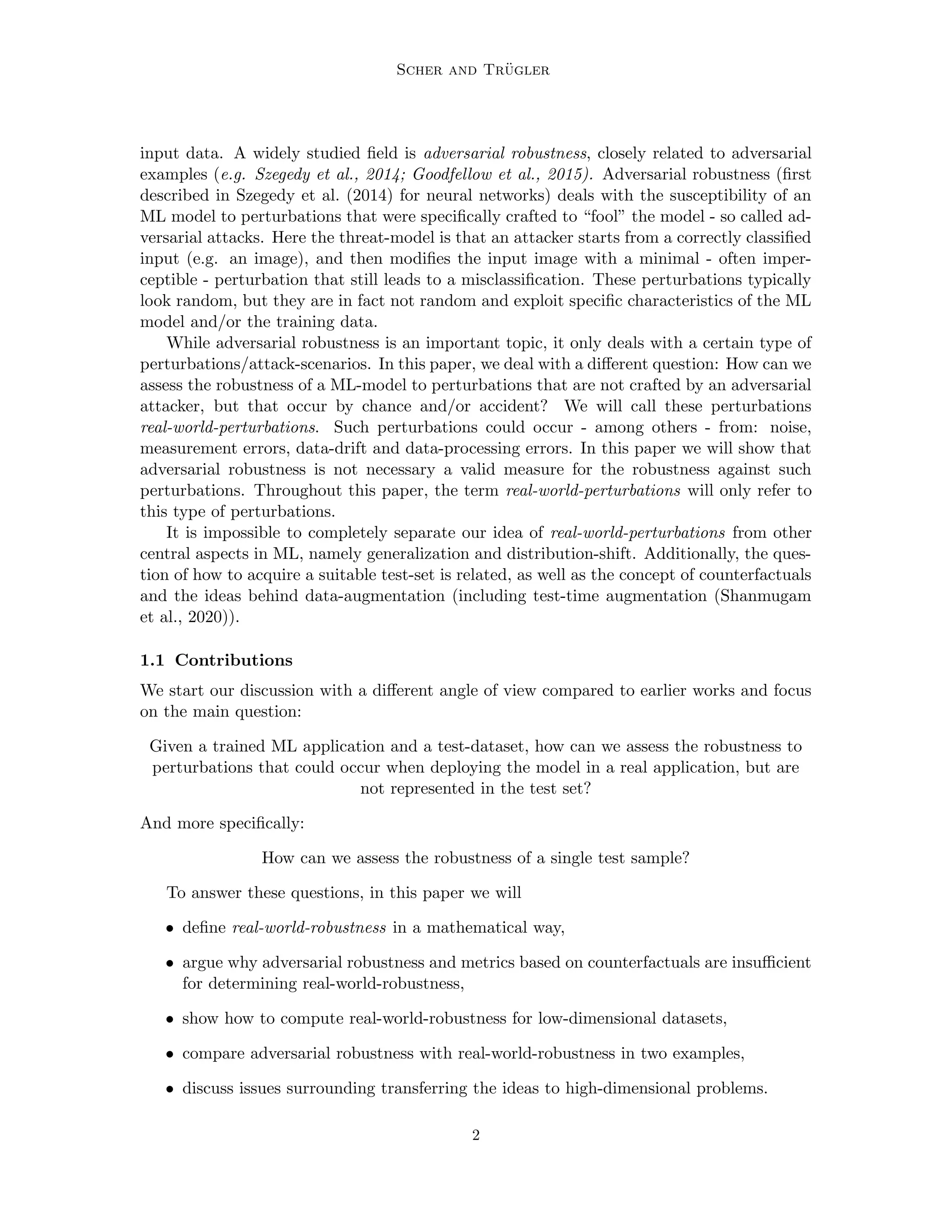

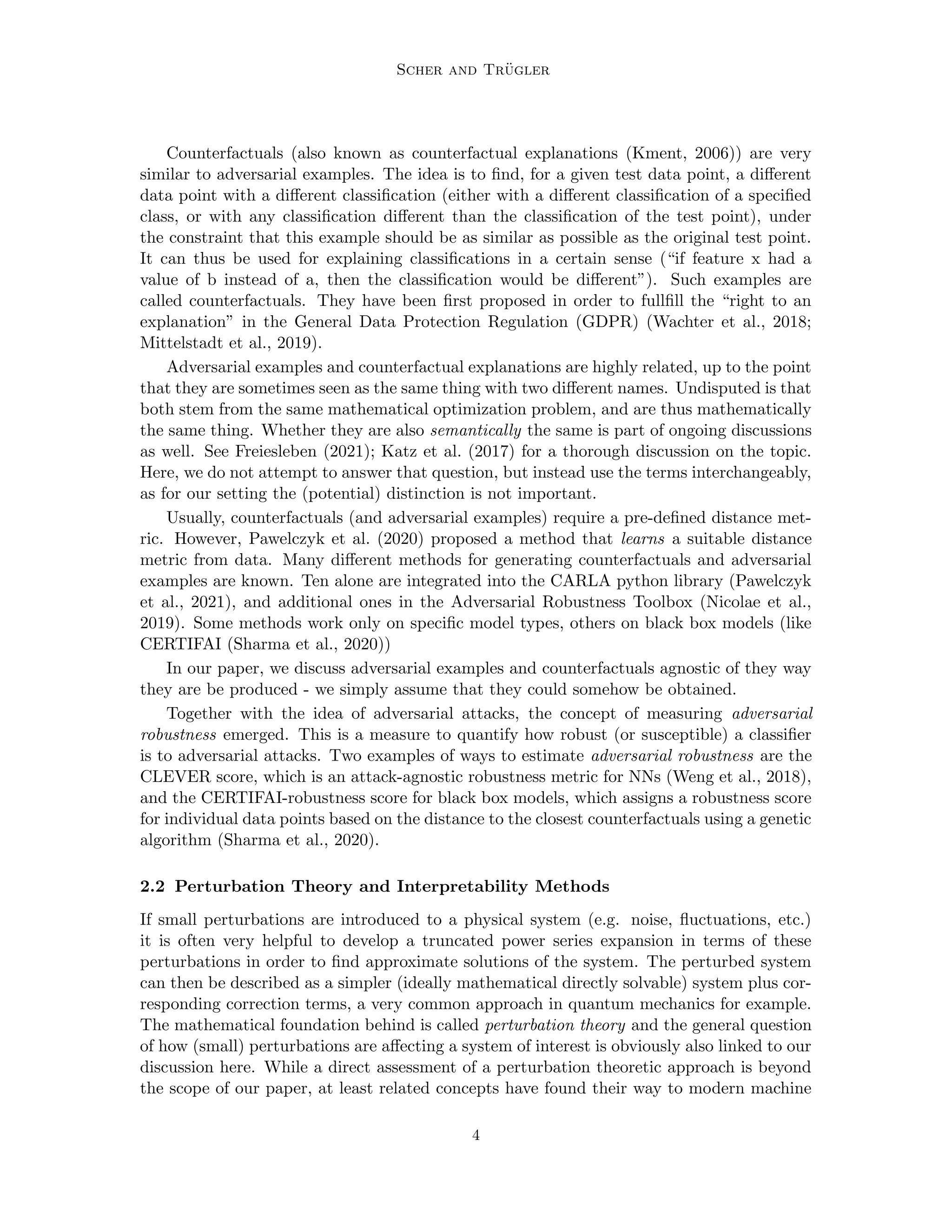
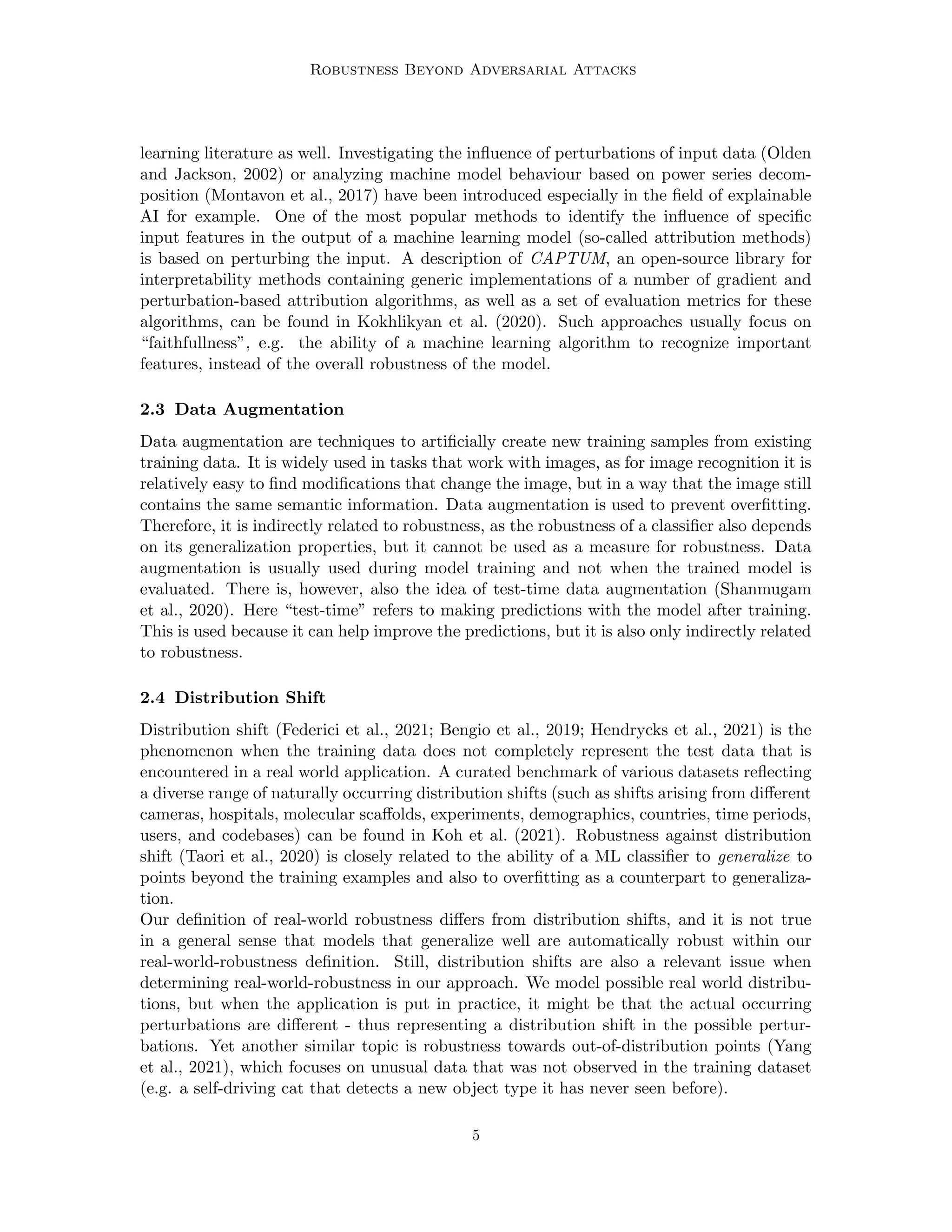
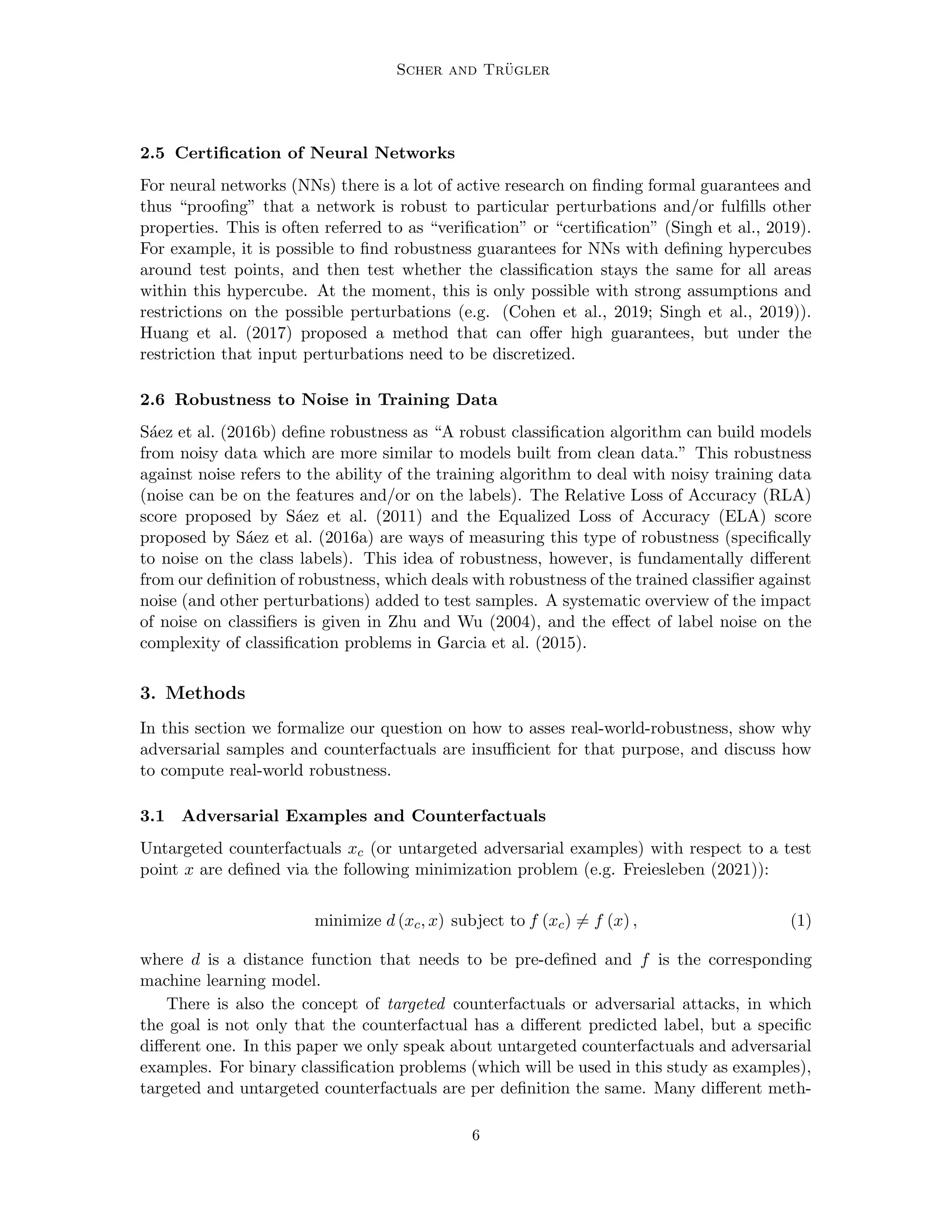

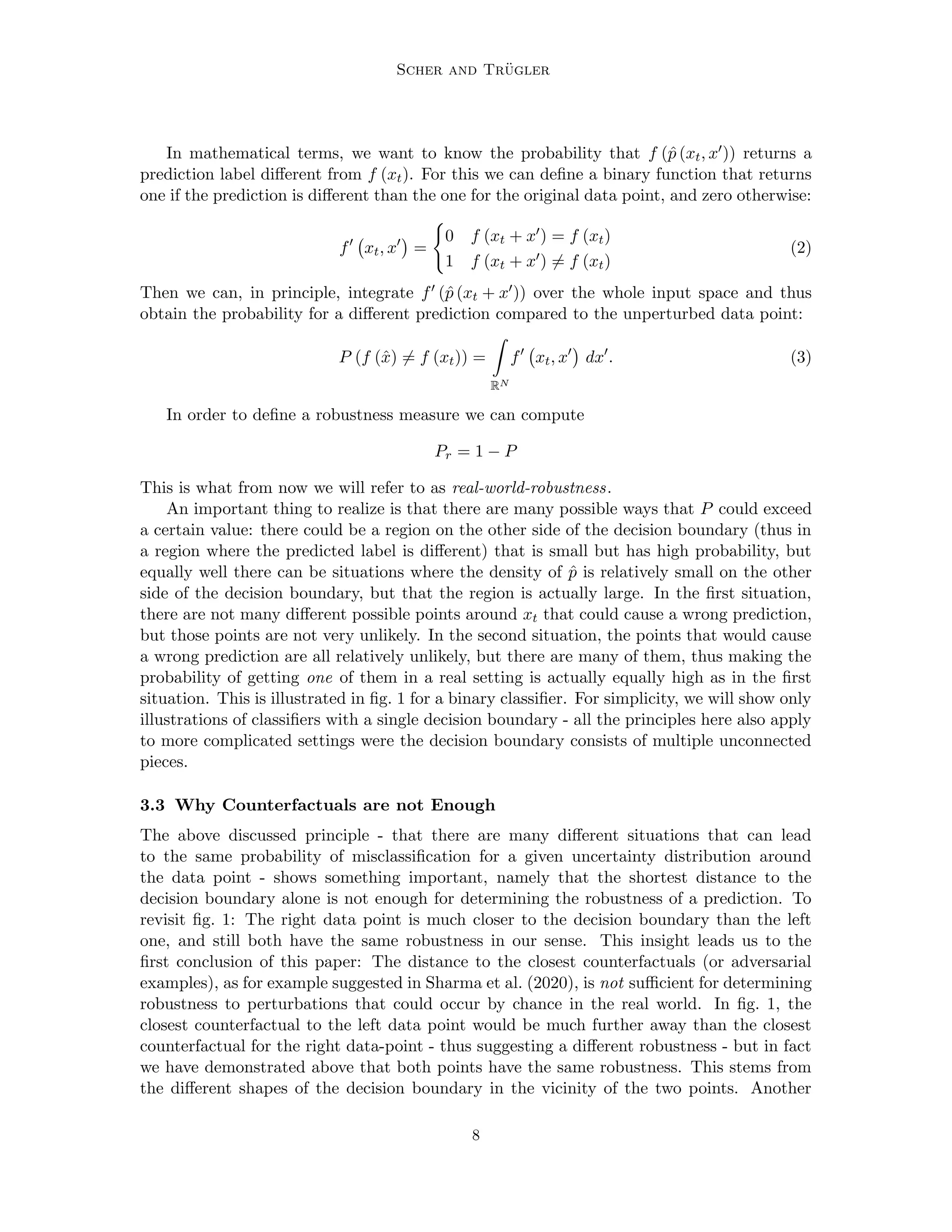
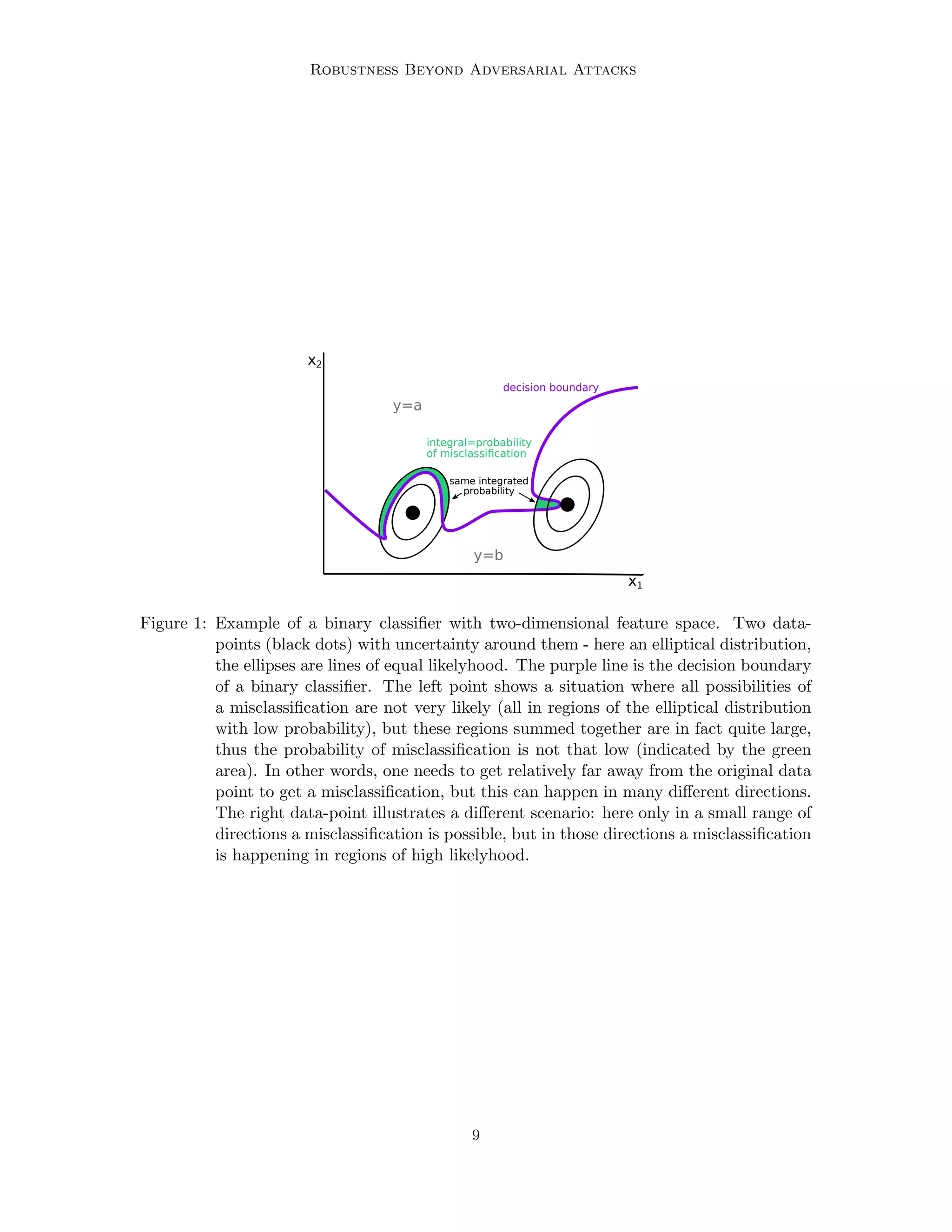
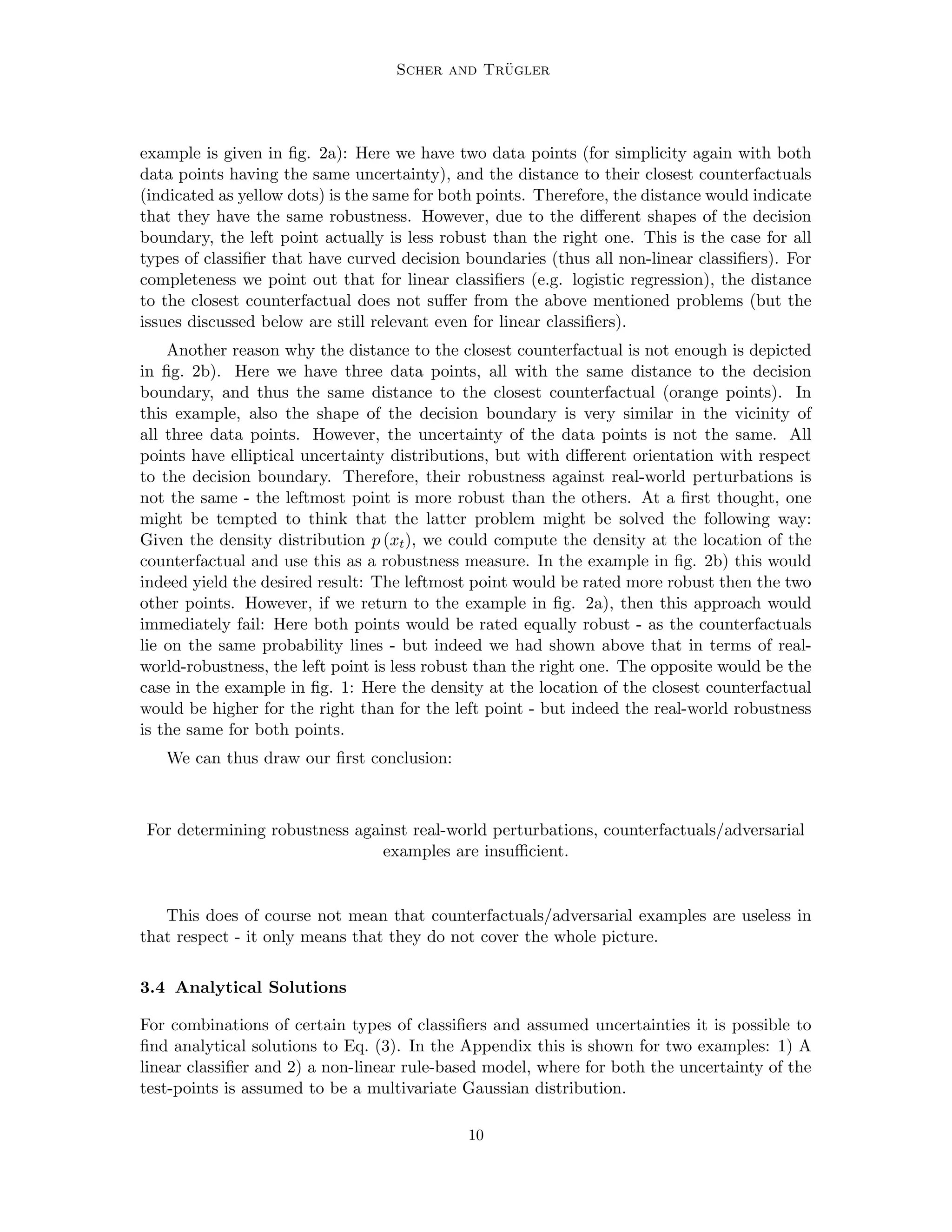
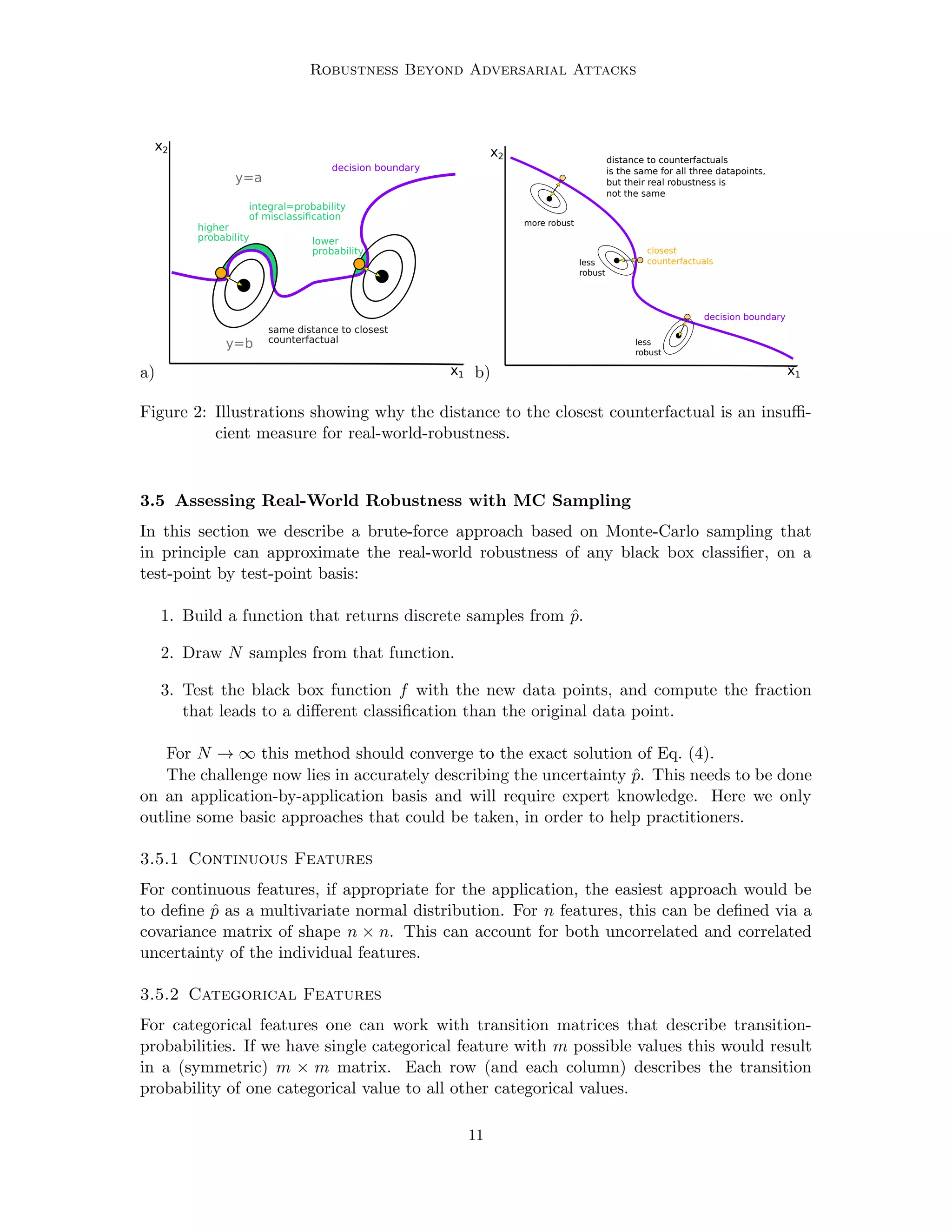
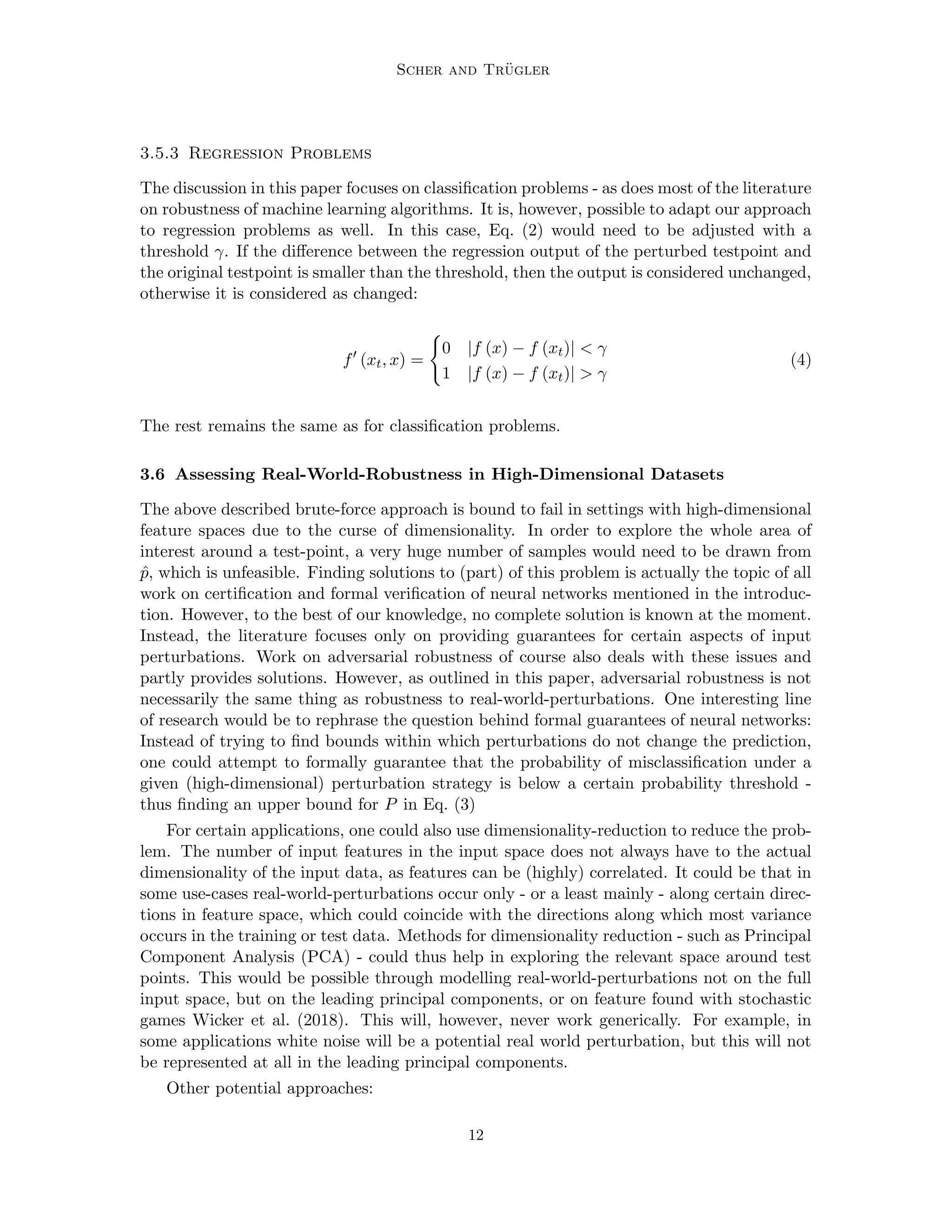
![Robustness Beyond Adversarial Attacks
• Try to use multiple different adversarial examples (e.g. not only the example closest
to the original point, but the n closest ones) as guidance towards the ”interesting”
direction(s) in feature space.
• For classifiers where the gradient of the output is available (e.g. for neural networks),
it would be possible to compare the direction of the largest absolute gradient at the
testpoint with the direction of highest probability in the assumed perturbation distri-
bution around the test point. If the two directions are similar, then the robustness is
lower. This could for example be based on the approach used in the CLEVER score
of Weng et al. (2018). Such an approach would be, however, closer to an extension of
adversarial robustness with information on perturbation distributions than a solution
for finding real-world-robustness in our definition.
4. Examples
In this section we compare adversarial robustness with real-world robustness on classifiers
trained on two datasets: The Iris flower dataset (Anderson, 1936) and the Ionosphere
dataset (Sigillito et al., 1989), both available in the UCI repository (Dua and Graff, 2017).
The experiments we conduct are mainly for illustration purposes. On both datasets, a
classifier is trained, and then robustness is estimated with different assumptions on how
real-world perturbations could look like. We simply use two approaches as illustrations of
the concept, they do not necessarily correspond to what would be real-world perturbations
in applications that use classifiers based on these datasets.
For both datasets, we describe the expected uncertainty around the test-point as mul-
tivariate normal distributions, which are the same for each point (we thus assume that
the uncertainty of input features is independent of their value). The multivariate normal
distribution is described by a covariance matrix normalized to a trace of 1, and an overall
perturbation scale, which in our example is a scalar. We use two types of covariance matri-
ces, an identity matrix (no covariance terms, all diagonal terms 1) and random covariance
matrices (normalized to a trace of 1). The random covariance matrices are generated the
following way:
Cr = AT
A, (5)
where A is a matrix whose entries are all independently drawn from a normal distribution
with zero mean and unit variance. Eq. (5) ensures that Cr is a proper covariance matrix
(symmetric and positive semi-definite).
Real-world-robustness in our definition is a probability, and therefore contained in [0, 1].
The typical way of using adversarial examples as robustness measure is the distance di
between the test point xi and the closest adversarial example. This is a metric in (0, inf)
(in contrast to real-world-robustness, the distance cannot be zero, therefore the interval has
an open lower bound). In order to allow a better comparison, we rescale the distance to
the range (0, 1], thus we define adversarial robustness as
ri =
di
max (d1,2,.....N )
.
For each test point, N = 10000 samples from the perturbation distribution around the
test point are drawn for computing real-world-robustness.
13](https://image.slidesharecdn.com/robustnessofmachinelearningmodelsbeyondadversarialattacks-221118154750-1394e022/75/Robustness-of-Machine-Learning-Models-Beyond-Adversarial-Attacks-pdf-13-2048.jpg)
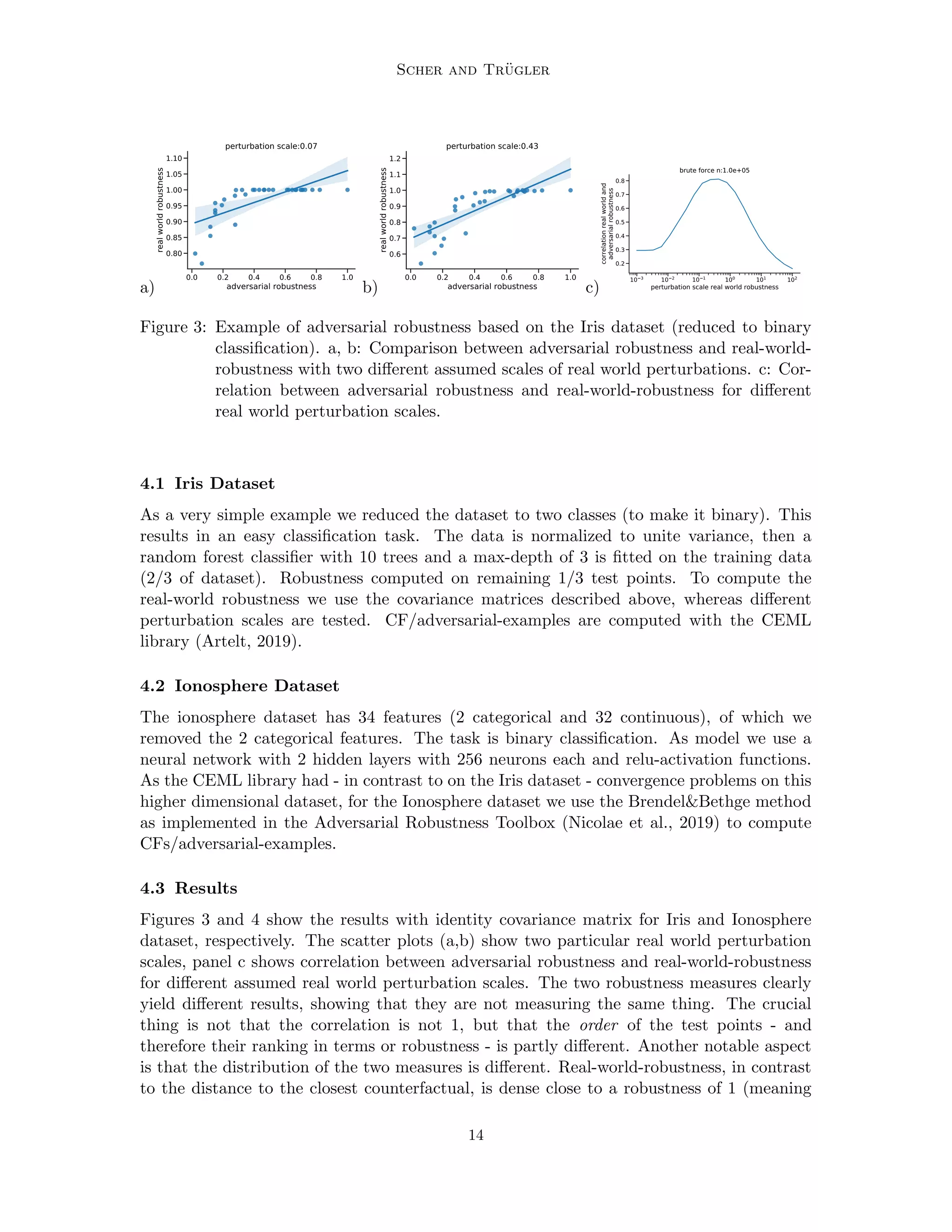
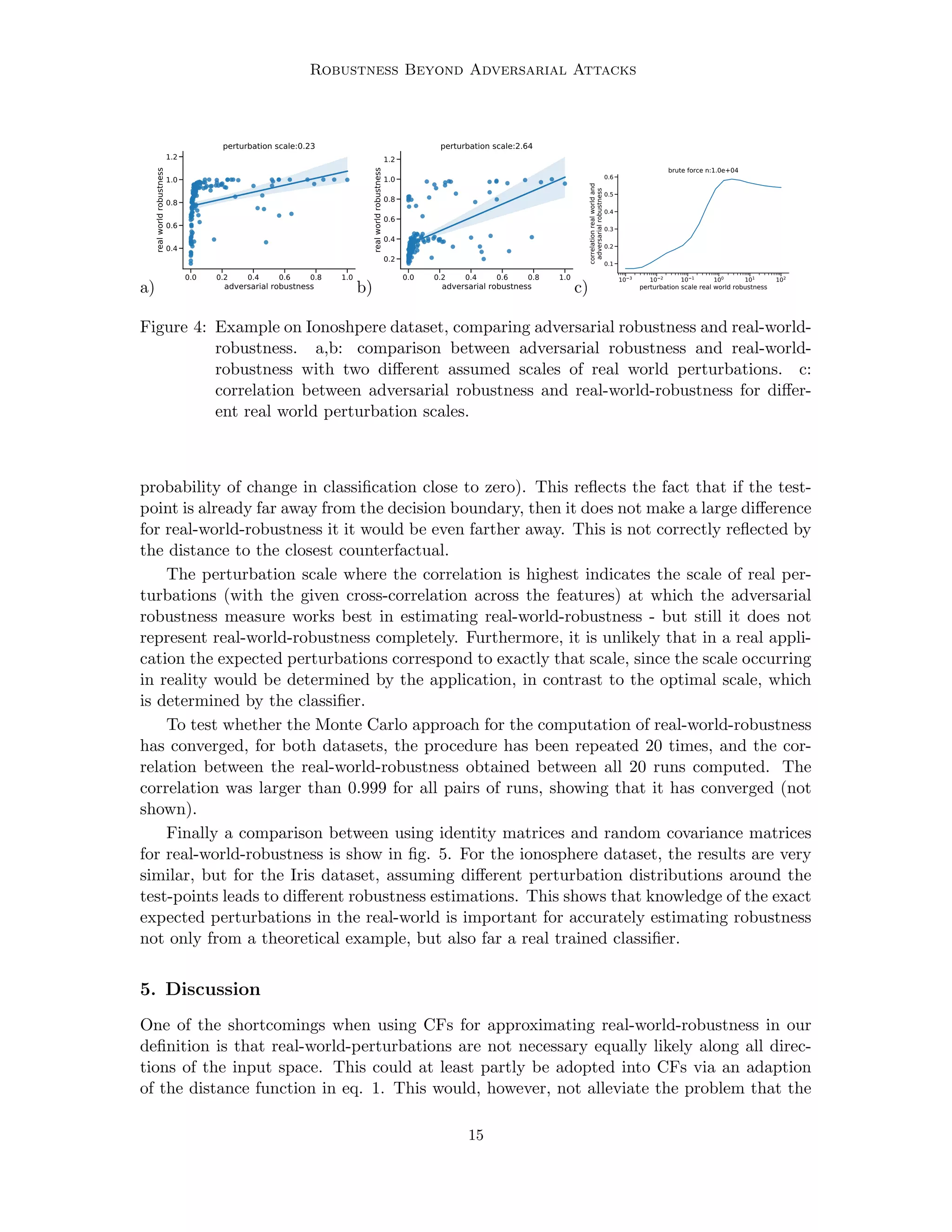
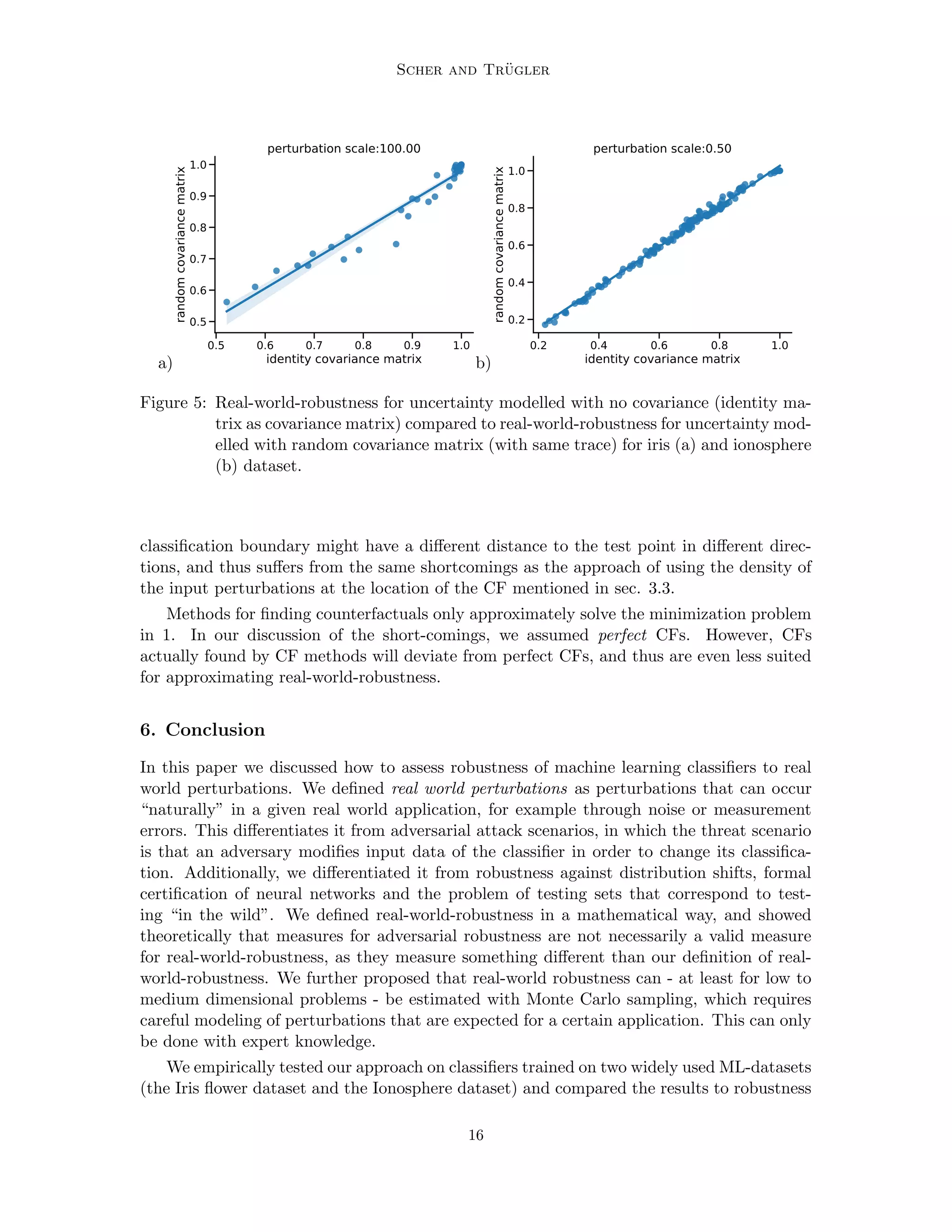
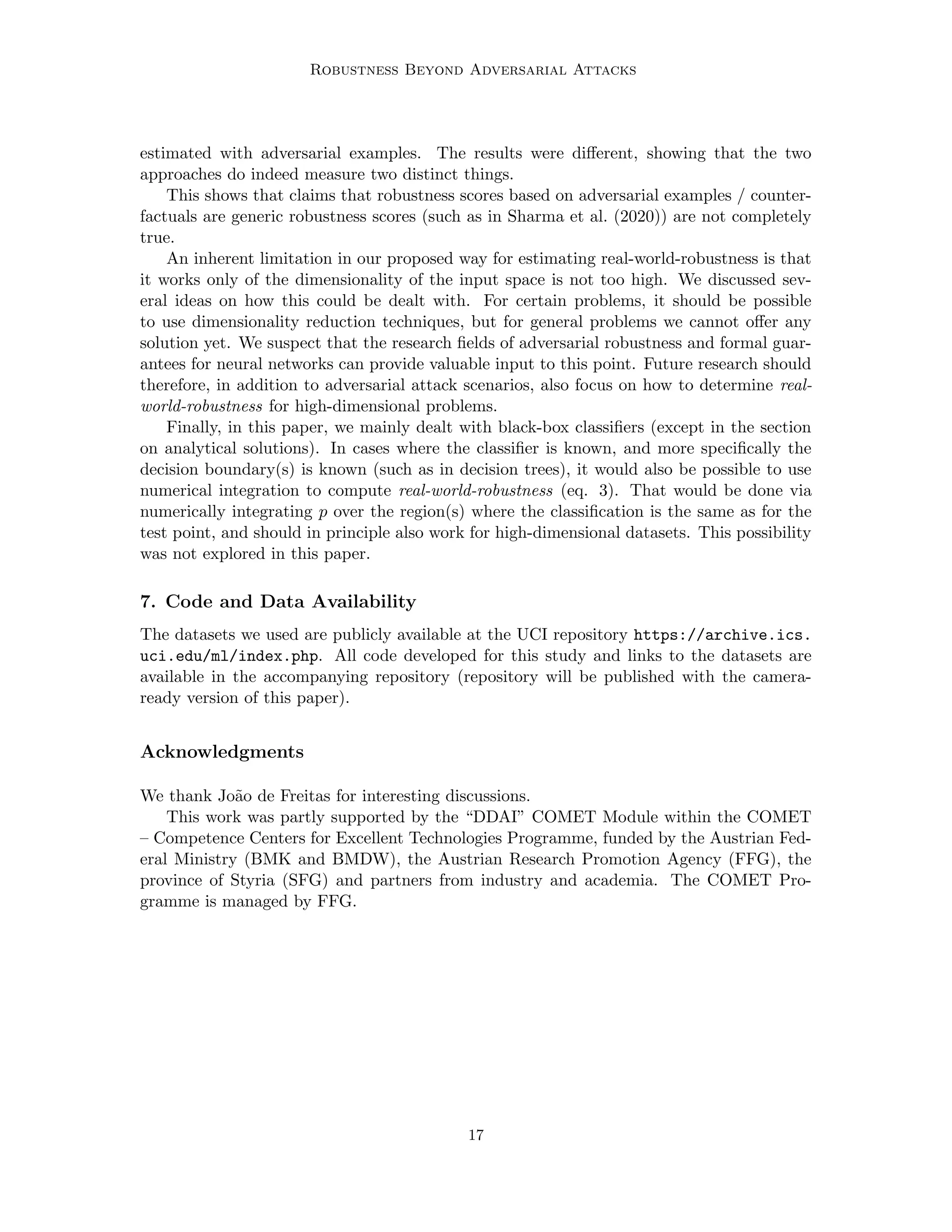
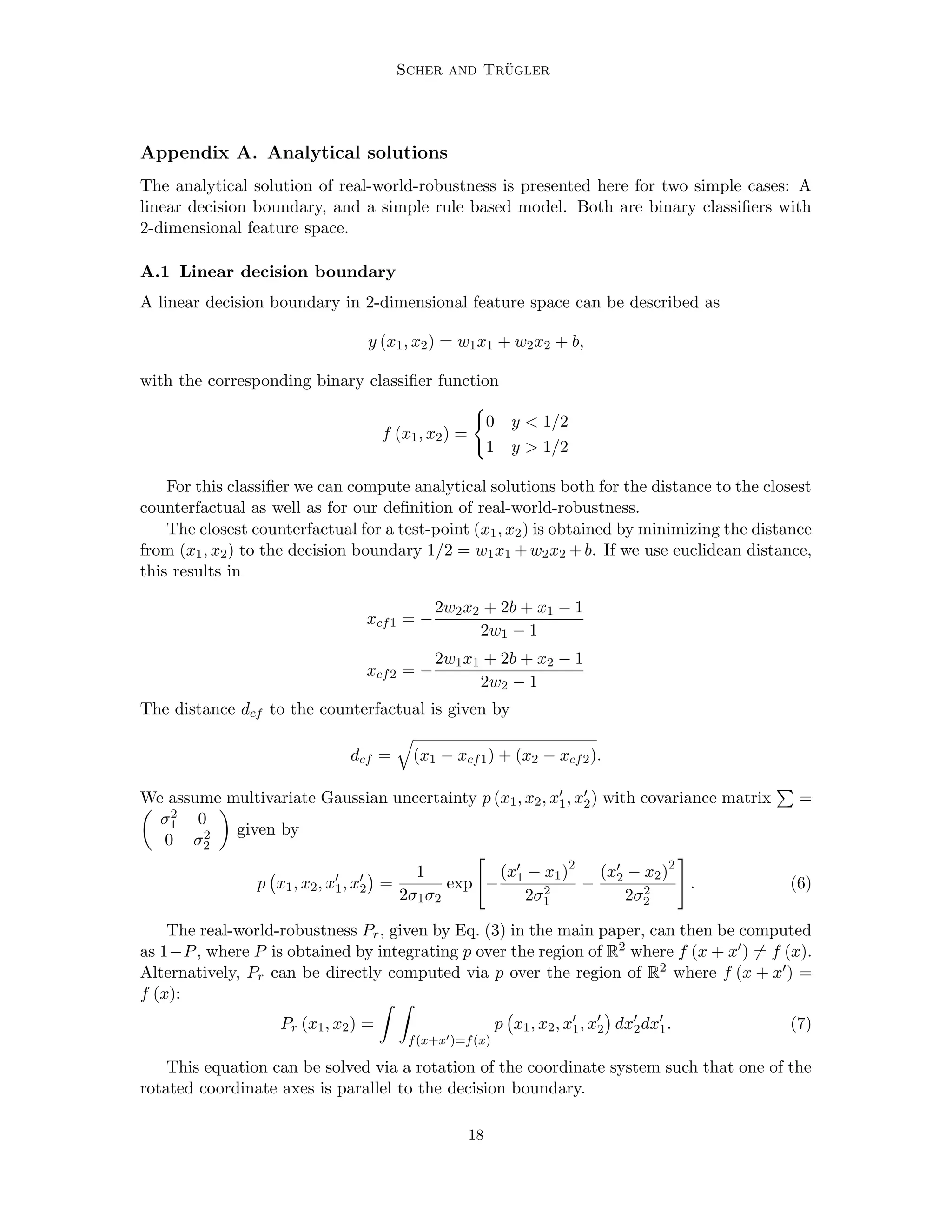
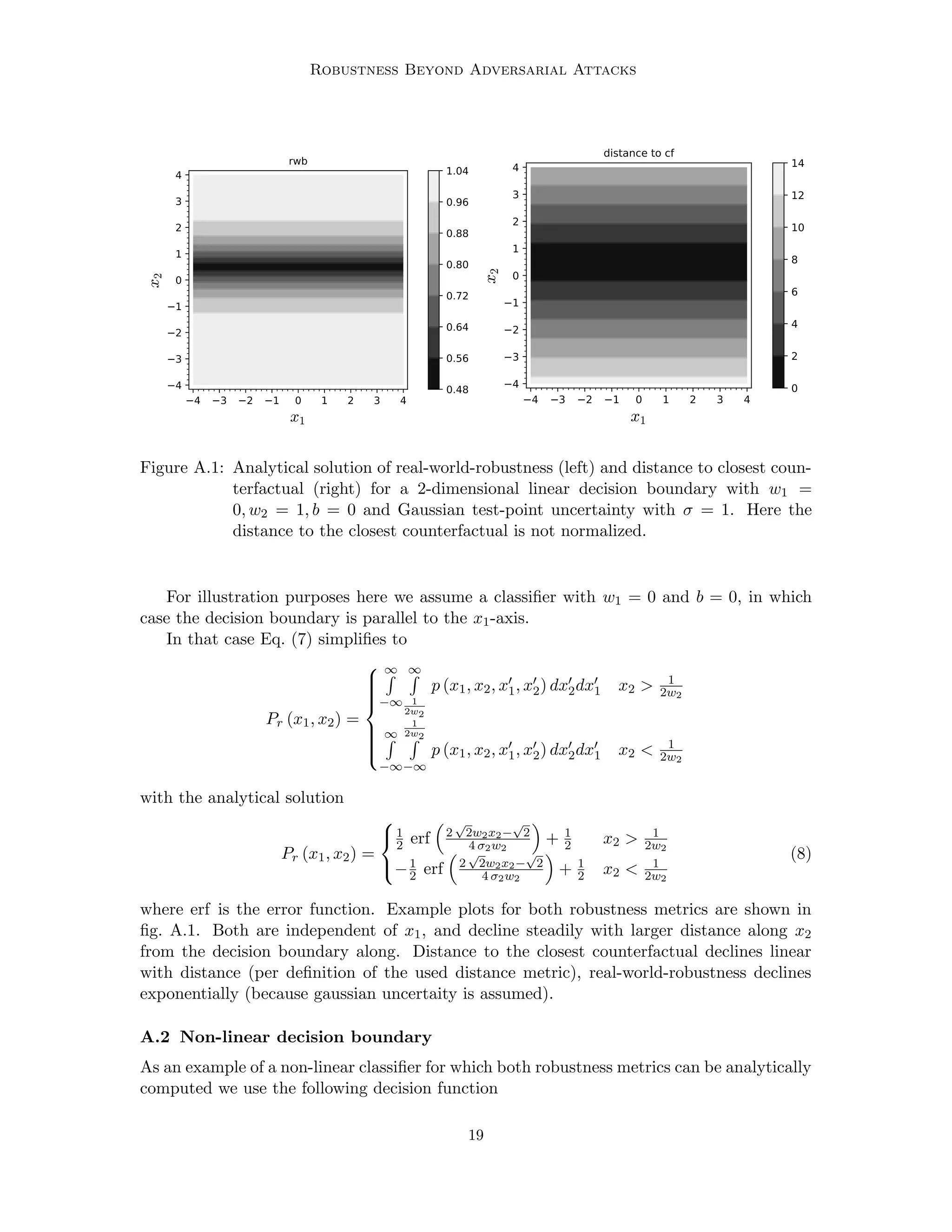
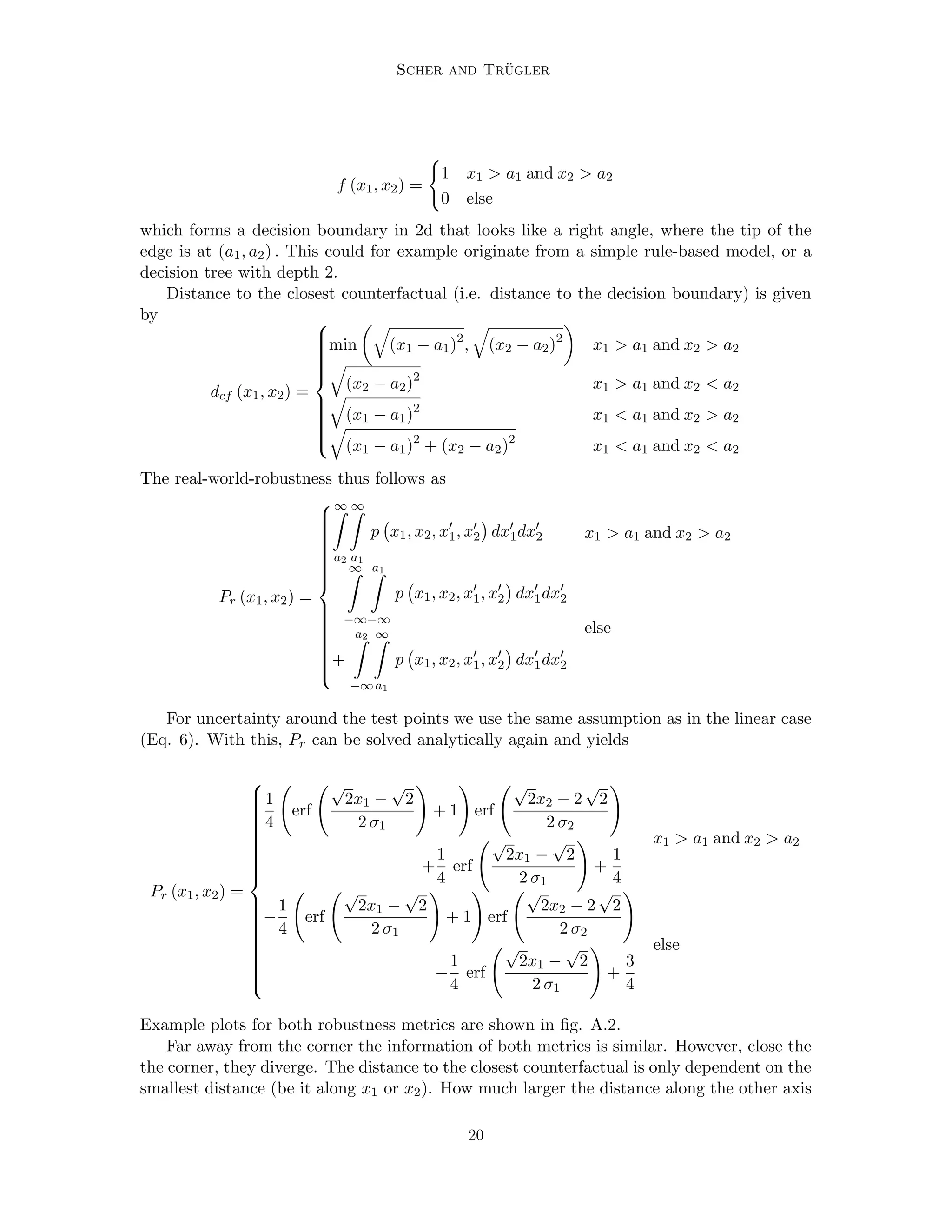
![Robustness Beyond Adversarial Attacks
2 1 0 1 2 3 4 5 6
x1
2
1
0
1
2
3
4
5
6
x
2 rwb
0.2
0.3
0.4
0.5
0.6
0.7
0.8
0.9
1.0
2 1 0 1 2 3 4 5 6
x1
2
1
0
1
2
3
4
5
6
x
2
distance to cf
0.0
0.8
1.6
2.4
3.2
4.0
4.8
5.6
Figure A.2: Analytical solution of real-world-robustness (left) and distance to closest coun-
terfactuel (right) for a 2-dimensional linear decision boundary with w1 =
0, w2 = 1, b = 0 and Gaussian test-point uncertainty with σ = 1. Here the
distance to the closest counterfactual is not normalized.
is does not matter in this case. This is in contrast to our definition of real-world-robustness,
where it does matter: In close vicinity to the edges the decision boundary is close in both
directions, making the prediction less robust, as it can change from perturbations along both
axes. This is not correctly reflected when using the distance to the closest counterfactual
as robustness metric.
References
Edgar Anderson. The Species Problem in Iris. Annals of the Missouri Botanical Garden,
23(3):457, September 1936. ISSN 00266493. doi: 10.2307/2394164.
André Artelt. CEML: Counterfactuals for explaining machine learning models - a python
toolbox, 2019.
Yoshua Bengio, Tristan Deleu, Nasim Rahaman, Rosemary Ke, Sébastien Lachapelle, Olexa
Bilaniuk, Anirudh Goyal, and Christopher Pal. A meta-transfer objective for learning to
disentangle causal mechanisms, 2019.
Jeremy M. Cohen, Elan Rosenfeld, and J. Zico Kolter. Certified Adversarial Robustness
via Randomized Smoothing. arXiv:1902.02918 [cs, stat], June 2019.
Dheeru Dua and Casey Graff. UCI machine learning repository, 2017.
Kevin Eykholt, Ivan Evtimov, Earlence Fernandes, Bo Li, Amir Rahmati, Chaowei Xiao,
Atul Prakash, Tadayoshi Kohno, and Dawn Song. Robust Physical-World Attacks on
Deep Learning Models. arXiv:1707.08945 [cs], April 2018.
21](https://image.slidesharecdn.com/robustnessofmachinelearningmodelsbeyondadversarialattacks-221118154750-1394e022/75/Robustness-of-Machine-Learning-Models-Beyond-Adversarial-Attacks-pdf-21-2048.jpg)
![Scher and Trügler
Marco Federici, Ryota Tomioka, and Patrick Forré. An information-theoretic approach to
distribution shifts, 2021.
Timo Freiesleben. The Intriguing Relation Between Counterfactual Explanations and Ad-
versarial Examples. arXiv:2009.05487 [cs], August 2021.
Luı́s P. F. Garcia, André C. P. L. F. de Carvalho, and Ana C. Lorena. Effect of label noise
in the complexity of classification problems. Neurocomputing, 160:108–119, July 2015.
ISSN 0925-2312. doi: 10.1016/j.neucom.2014.10.085.
Ian J. Goodfellow, Jonathon Shlens, and Christian Szegedy. Explaining and Harnessing
Adversarial Examples. arXiv:1412.6572 [cs, stat], March 2015.
Dan Hendrycks, Steven Basart, Norman Mu, Saurav Kadavath, Frank Wang, Evan
Dorundo, Rahul Desai, Tyler Zhu, Samyak Parajuli, Mike Guo, Dawn Song, Jacob Stein-
hardt, and Justin Gilmer. The many faces of robustness: A critical analysis of out-of-
distribution generalization. In Proceedings of the IEEE/CVF International Conference
on Computer Vision (ICCV), pages 8340–8349, October 2021.
Xiaowei Huang, Marta Kwiatkowska, Sen Wang, and Min Wu. Safety verification of deep
neural networks. In International conference on computer aided verification, pages 3–29.
Springer, 2017.
Xiaowei Huang, Daniel Kroening, Wenjie Ruan, James Sharp, Youcheng Sun, Emese
Thamo, Min Wu, and Xinping Yi. A survey of safety and trustworthiness of deep neu-
ral networks: Verification, testing, adversarial attack and defence, and interpretability.
Computer Science Review, 37:100270, 2020. ISSN 1574-0137. doi: https://doi.org/10.
1016/j.cosrev.2020.100270. URL https://www.sciencedirect.com/science/article/
pii/S1574013719302527.
Andrew Ilyas, Shibani Santurkar, Dimitris Tsipras, Logan Engstrom, Brandon Tran, and
Aleksander Madry. Adversarial Examples Are Not Bugs, They Are Features. In Advances
in Neural Information Processing Systems, volume 32. Curran Associates, Inc., 2019.
Guy Katz, Clark Barrett, David Dill, Kyle Julian, and Mykel Kochenderfer. Reluplex: An
Efficient SMT Solver for Verifying Deep Neural Networks. arXiv:1702.01135 [cs], May
2017.
Boris Kment. Counterfactuals and explanation. Mind, 115(458):261–310, 2006. doi: 10.
1093/mind/fzl261.
Pang Wei Koh, Shiori Sagawa, Henrik Marklund, Sang Michael Xie, Marvin Zhang, Akshay
Balsubramani, Weihua Hu, Michihiro Yasunaga, Richard Lanas Phillips, Irena Gao, Tony
Lee, Etienne David, Ian Stavness, Wei Guo, Berton Earnshaw, Imran Haque, Sara M
Beery, Jure Leskovec, Anshul Kundaje, Emma Pierson, Sergey Levine, Chelsea Finn, and
Percy Liang. Wilds: A benchmark of in-the-wild distribution shifts. In Marina Meila
and Tong Zhang, editors, Proceedings of the 38th International Conference on Machine
Learning, volume 139 of Proceedings of Machine Learning Research, pages 5637–5664.
PMLR, 18–24 Jul 2021. URL https://proceedings.mlr.press/v139/koh21a.html.
22](https://image.slidesharecdn.com/robustnessofmachinelearningmodelsbeyondadversarialattacks-221118154750-1394e022/75/Robustness-of-Machine-Learning-Models-Beyond-Adversarial-Attacks-pdf-22-2048.jpg)
![Robustness Beyond Adversarial Attacks
Narine Kokhlikyan, Vivek Miglani, Miguel Martin, Edward Wang, Bilal Alsallakh, Jonathan
Reynolds, Alexander Melnikov, Natalia Kliushkina, Carlos Araya, Siqi Yan, and Orion
Reblitz-Richardson. Captum: A unified and generic model interpretability library for
pytorch, 2020.
Dhireesha Kudithipudi, Mario Aguilar-Simon, Jonathan Babb, Maxim Bazhenov, Douglas
Blackiston, Josh Bongard, Andrew P. Brna, Suraj Chakravarthi Raja, Nick Cheney, Jeff
Clune, Anurag Daram, Stefano Fusi, Peter Helfer, Leslie Kay, Nicholas Ketz, Zsolt Kira,
Soheil Kolouri, Jeffrey L. Krichmar, Sam Kriegman, Michael Levin, Sandeep Madireddy,
Santosh Manicka, Ali Marjaninejad, Bruce McNaughton, Risto Miikkulainen, Zaneta
Navratilova, Tej Pandit, Alice Parker, Praveen K. Pilly, Sebastian Risi, Terrence J. Se-
jnowski, Andrea Soltoggio, Nicholas Soures, Andreas S. Tolias, Darı́o Urbina-Meléndez,
Francisco J. Valero-Cuevas, Gido M. van de Ven, Joshua T. Vogelstein, Felix Wang, Ron
Weiss, Angel Yanguas-Gil, Xinyun Zou, and Hava Siegelmann. Biological underpinnings
for lifelong learning machines. Nature Machine Intelligence, 4(3):196–210, mar 2022. doi:
10.1038/s42256-022-00452-0.
Alexey Kurakin, Ian Goodfellow, and Samy Bengio. Adversarial examples in the physical
world. arXiv:1607.02533 [cs, stat], February 2017.
Brent Mittelstadt, Chris Russell, and Sandra Wachter. Explaining explanations in ai.
In Proceedings of the Conference on Fairness, Accountability, and Transparency, FAT*
’19, page 279–288, New York, NY, USA, 2019. Association for Computing Machinery.
ISBN 9781450361255. doi: 10.1145/3287560.3287574. URL https://doi.org/10.1145/
3287560.3287574.
Grégoire Montavon, Sebastian Lapuschkin, Alexander Binder, Wojciech Samek, and Klaus-
Robert Müller. Explaining nonlinear classification decisions with deep taylor decompo-
sition. Pattern Recognition, 65:211–222, 2017. ISSN 0031-3203. doi: https://doi.org/10.
1016/j.patcog.2016.11.008. URL https://www.sciencedirect.com/science/article/
pii/S0031320316303582.
Maria-Irina Nicolae, Mathieu Sinn, Minh Ngoc Tran, Beat Buesser, Ambrish Rawat, Martin
Wistuba, Valentina Zantedeschi, Nathalie Baracaldo, Bryant Chen, Heiko Ludwig, Ian M.
Molloy, and Ben Edwards. Adversarial Robustness Toolbox v1.0.0. arXiv:1807.01069 [cs,
stat], November 2019.
NIST. Draft - Taxonomy of AI Risk. page 9, 2021.
Julian D Olden and Donald A Jackson. Illuminating the “black box”: a randomization
approach for understanding variable contributions in artificial neural networks. Ecological
modelling, 154(1-2):135–150, 2002.
Martin Pawelczyk, Johannes Haug, Klaus Broelemann, and Gjergji Kasneci. Learning
Model-Agnostic Counterfactual Explanations for Tabular Data. Proceedings of The Web
Conference 2020, pages 3126–3132, April 2020. doi: 10.1145/3366423.3380087.
23](https://image.slidesharecdn.com/robustnessofmachinelearningmodelsbeyondadversarialattacks-221118154750-1394e022/75/Robustness-of-Machine-Learning-Models-Beyond-Adversarial-Attacks-pdf-23-2048.jpg)
![Scher and Trügler
Martin Pawelczyk, Sascha Bielawski, Johannes van den Heuvel, Tobias Richter, and Gjergji
Kasneci. CARLA: A Python Library to Benchmark Algorithmic Recourse and Counter-
factual Explanation Algorithms. arXiv:2108.00783 [cs], August 2021.
José A Sáez, Julián Luengo, and Francisco Herrera. Evaluating the classifier behavior
with noisy data considering performance and robustness: The equalized loss of accuracy
measure. Neurocomputing, 176:26–35, 2016a.
José A. Sáez, Julián Luengo, and Francisco Herrera. Evaluating the classifier behavior with
noisy data considering performance and robustness: The Equalized Loss of Accuracy
measure. Neurocomputing, 176:26–35, February 2016b. ISSN 0925-2312. doi: 10.1016/j.
neucom.2014.11.086.
Divya Shanmugam, Davis Blalock, Guha Balakrishnan, and John Guttag. When and Why
Test-Time Augmentation Works. arXiv:2011.11156 [cs], November 2020.
Shubham Sharma, Jette Henderson, and Joydeep Ghosh. CERTIFAI: A Common Frame-
work to Provide Explanations and Analyse the Fairness and Robustness of Black-box
Models. In Proceedings of the AAAI/ACM Conference on AI, Ethics, and Society, pages
166–172, New York NY USA, February 2020. ACM. ISBN 978-1-4503-7110-0. doi:
10.1145/3375627.3375812.
Vincent G Sigillito, Simon P Wing, Larrie V Hutton, and Kile B Baker. Classification of
radar returns from the ionosphere using neural networks. Johns Hopkins APL Technical
Digest, 10(3):262–266, 1989.
Gagandeep Singh, Timon Gehr, Markus Püschel, and Martin Vechev. An abstract domain
for certifying neural networks. Proceedings of the ACM on Programming Languages, 3
(POPL):1–30, January 2019. ISSN 2475-1421. doi: 10.1145/3290354.
Supreme Audit Institutions of Finland, Germany, the Netherlands, Norway and the UK.
Auditing machine learning algorithms - A white paper for public auditors. Technical
report, 2020.
Christian Szegedy, Wojciech Zaremba, Ilya Sutskever, Joan Bruna, Dumitru Erhan, Ian
Goodfellow, and Rob Fergus. Intriguing properties of neural networks. arXiv:1312.6199
[cs], February 2014.
José A. Sáez, Julián Luengo, and Francisco Herrera. Fuzzy rule based classification systems
versus crisp robust learners trained in presence of class noise’s effects: A case of study.
In 2011 11th International Conference on Intelligent Systems Design and Applications,
pages 1229–1234, 2011. doi: 10.1109/ISDA.2011.6121827.
Thomas Tanay and Lewis Griffin. A Boundary Tilting Persepective on the Phenomenon of
Adversarial Examples. arXiv:1608.07690 [cs, stat], August 2016.
Rohan Taori, Achal Dave, Vaishaal Shankar, Nicholas Carlini, Benjamin Recht, and Lud-
wig Schmidt. Measuring robustness to natural distribution shifts in image classifica-
tion. In H. Larochelle, M. Ranzato, R. Hadsell, M. F. Balcan, and H. Lin, editors,
24](https://image.slidesharecdn.com/robustnessofmachinelearningmodelsbeyondadversarialattacks-221118154750-1394e022/75/Robustness-of-Machine-Learning-Models-Beyond-Adversarial-Attacks-pdf-24-2048.jpg)
![Robustness Beyond Adversarial Attacks
Advances in Neural Information Processing Systems, volume 33, pages 18583–18599. Cur-
ran Associates, Inc., 2020. URL https://proceedings.neurips.cc/paper/2020/file/
d8330f857a17c53d217014ee776bfd50-Paper.pdf.
Sandra Wachter, Brent Mittelstadt, and Chris Russell. Counterfactual Explanations with-
out Opening the Black Box: Automated Decisions and the GDPR. arXiv:1711.00399
[cs], March 2018.
Tsui-Wei Weng, Huan Zhang, Pin-Yu Chen, Jinfeng Yi, Dong Su, Yupeng Gao, Cho-Jui
Hsieh, and Luca Daniel. Evaluating the Robustness of Neural Networks: An Extreme
Value Theory Approach. arXiv:1801.10578 [cs, stat], January 2018.
Matthew Wicker, Xiaowei Huang, and Marta Kwiatkowska. Feature-Guided Black-Box
Safety Testing of Deep Neural Networks. arXiv:1710.07859 [cs], February 2018.
Philip Matthias Winter, Sebastian Eder, Johannes Weissenböck, Christoph Schwald,
Thomas Doms, Tom Vogt, Sepp Hochreiter, and Bernhard Nessler. Trusted Artificial
Intelligence: Towards Certification of Machine Learning Applications. arXiv:2103.16910
[cs, stat], March 2021.
Jingkang Yang, Kaiyang Zhou, Yixuan Li, and Ziwei Liu. Generalized out-of-distribution
detection: A survey, 2021.
Xingquan Zhu and Xindong Wu. Class noise vs. attribute noise: A quantitative study.
Artificial intelligence review, 22(3):177–210, 2004.
25](https://image.slidesharecdn.com/robustnessofmachinelearningmodelsbeyondadversarialattacks-221118154750-1394e022/75/Robustness-of-Machine-Learning-Models-Beyond-Adversarial-Attacks-pdf-25-2048.jpg)